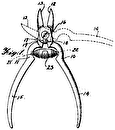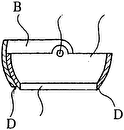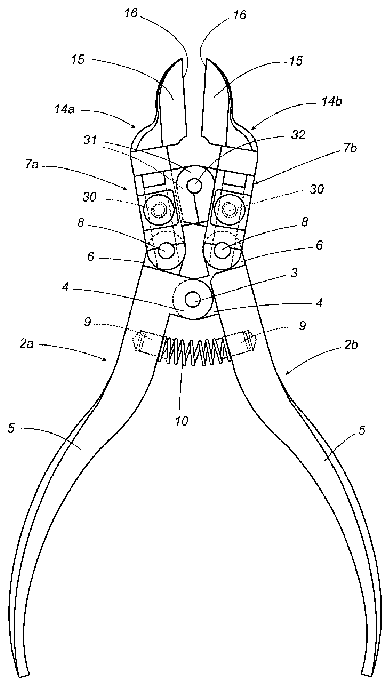
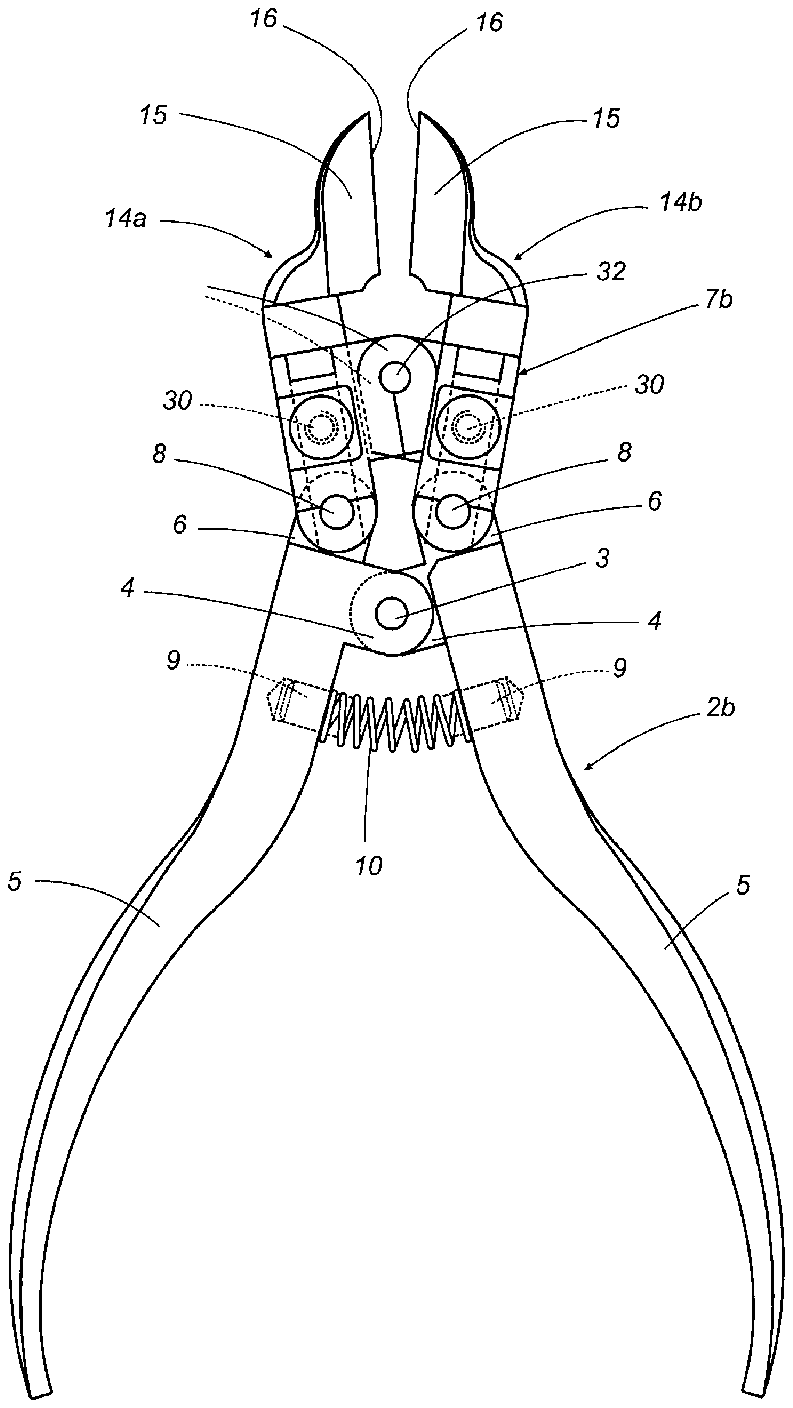
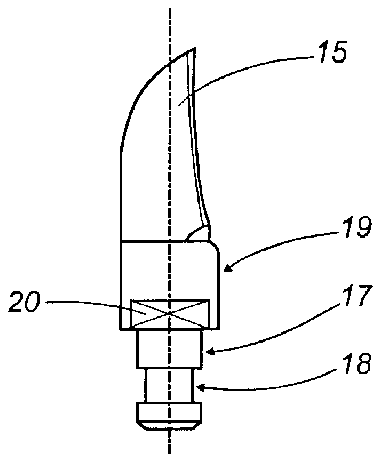

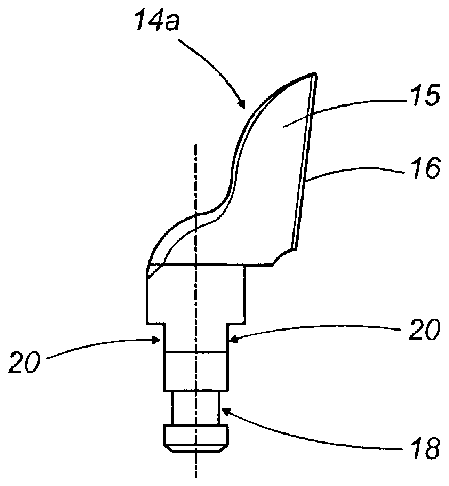

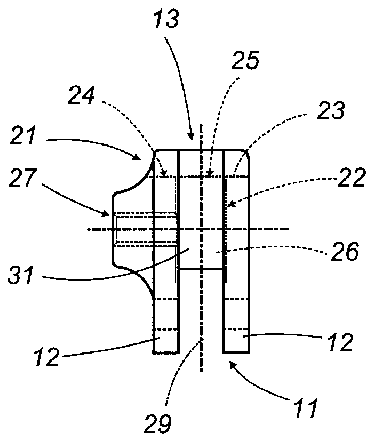
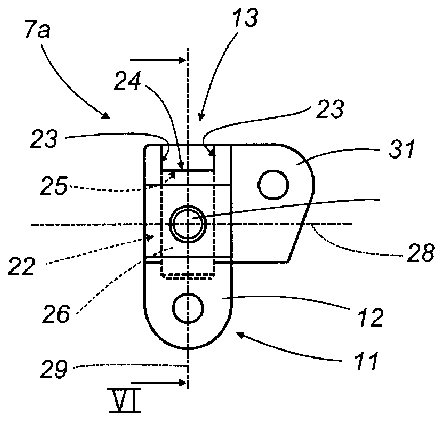
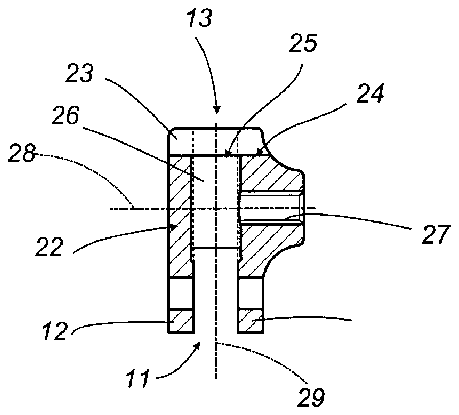
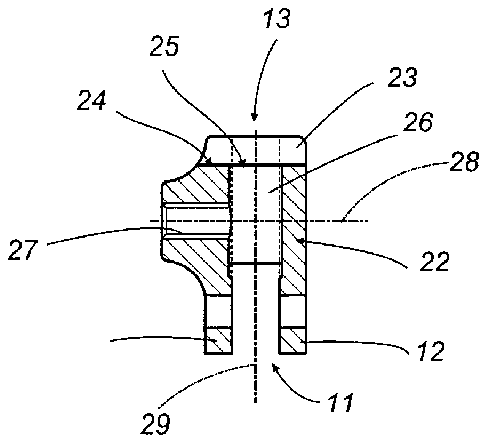
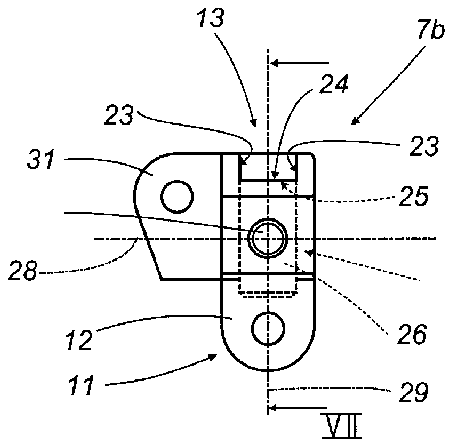
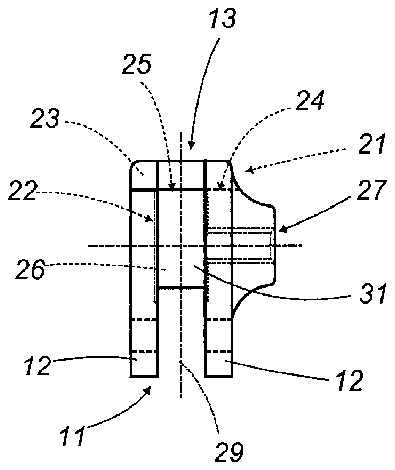
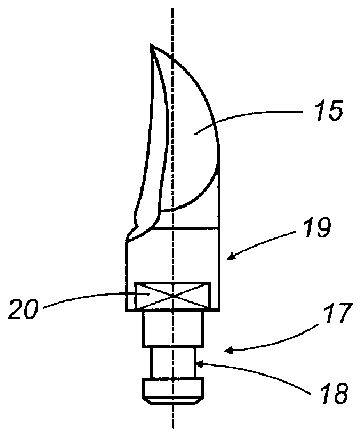
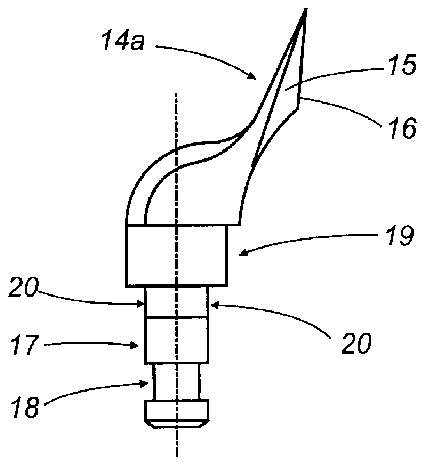
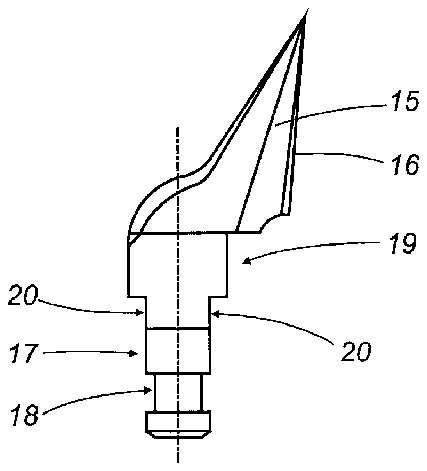
- 1nail clippers
- 2each arm
- 4own appendix
- 5handle
- 6end portion
- 7jaw holder
- 8pivot pin
- 9cylindrical element
- 10helical spring
- 11own end portion
- 12two appendices
- 13seat
- 14jaw
- 15tip
- 16cutting blade
- 17terminal body
- 18groove
- 19central body
- 20faces
- 21compartment
- 22second compartment
- 23walls
- 24wall
- 25circular hole
- 26cavity
- 27hole
- 28ent respective mutually orthogonal axes
- 31respective end appendices
- 32pivot pin
Abstract
A tool for the hygiene and cutting of cuticles, fingernails and toenails, wherein two interchangeable jaws, provided with respective cutting blades, are removably supported by two jaw holders connected to respective handles for gripping the tool itself; the jaw holders and the handles are mutually hinged to rotate the aforementioned jaws between an open position and a closed and cutting position.
Description
BACKGROUND OF THE INVENTION
The present invention relates to a tool for the hygiene and cutting cuticles, fingernails and toe nails.
In particular, the tool of the present invention is of the type commonly known by the name of nail clippers.
Known nail clippers usually comprise two metal arms mutually connected in crossed position by means of a pivot pin for the rotation of the arms themselves. Each arm presents, at opposite sides of the pivot pin, a longer portion, which is curved and shaped in such a way as to define a handle for gripping the nail clippers, and a shorter portion, which defines a jaw with a pointed end and provided with a cutting blade.
The blades of the two jaws are positioned facing each other and are forced against one another in a side-by-side cutting position when the handles are forced against one another in a close position of closure.
In such a tool, it is necessary for the blades to be sharpened periodically with sharpening operations which are rather costly. Moreover, each sharpening operation causes the tool to be unavailable for a more or less long period of time, thereby entailing the need to have a back-up tool available, with the deriving additional costs.
In addition to the aforesaid drawback, known nail clippers of the kind described above present the drawback of being difficult to sterilize in order to allow their hygienic use by more than one person. This difficulty fundamentally derives from the fact that known sterilizing fluids tend to oxidize its blades rather easily. On the other hand, dry sterilization is oftentimes not very effective and, hence, not very safe.
SUMMARY OF THE INVENTION
The aim of the present invention is to provide a tool for the hygiene and cutting of cuticles and fingernails and toe nails which is free from the drawbacks described above.
According to the present invention a tool for the hygiene and cutting of cuticles and fingernails and toe nails is provided, comprising two jaws provided with respective cutting blades, characterized in that it comprises two jaw holders able removably to support said jaws and mutually hinged to rotate the jaws themselves between an open position and a closed and cutting position; said jaws being interchangeable.
BRIEF DESCRIPTION OF THE DRAWINGS
The technical features of the invention, according to the aforesaid aims, can clearly be noted from the content of the claims set out below and its advantages shall become more readily apparent in the detailed description that follows, made with reference to the accompanying drawings, which represent an embodiment provided purely by way of non limiting example, in which:
FIG. 1 shows a front view of a preferred embodiment of the tool according to the present invention;
FIGS. 2, 3 , 5 , 8 and 11 show respective details of the tool of FIG. 1;
FIG. 4 shows a side view of the detail of FIG. 5;
FIG. 6 is a section according to the line VI—VI of the detail of FIG. 5;
FIG. 7 is a section view according to the line VII—VII of the detail of FIG. 8;
FIG. 9 shows a side view of the detail of FIG. 8;
FIGS. 10 and 12 show two side views of the detail of FIG. 11;
FIGS. 13 and 14 show front views of two different embodiments of the detail of FIG. 11 .
DESCRIPTION OF THE PREFERRED EMBODIMENT
With reference to FIG. 1, the reference number 1 indicates in its entirety a set of nail clippers for the hygiene and cutting of cuticles, fingernails and toenails.
The nail clippers 1 are wholly made of stainless steel and comprise two arms 2 a, 2 b mutually hinged by means of pivot pin 3 in correspondence with respective ends defined by appendices 4 .
Each arm 2 a, 2 b presents, at opposite sides of its own appendix 4 , a longer portion, which is curved and shaped in such a way as to define a handle 5 for gripping the nail clippers 1 , and a short end portion 6 , which bears hinged a respective jaw holder 7 a, 7 b by means of a pivot pin 8 .
In proximity to its own appendix 4 , at the opposite side of the end portion 6 , each arm 2 a, 2 b bears a screwed on cylindrical element 9 , which is oriented in the same direction as the appendix 4 itself and serves as an internal support element for a helical spring 10 interposed between the arms 2 a, 2 b themselves.
The jaw holder 7 a, shown in greater detail in FIGS. 4, 5 and 6 , is connected to the respective arm 2 a through its own end portion 11 defined by two appendices 12 positioned at opposite sides of the portion 6 and hinged thereon by means of the aforementioned pivot pin 8 .
The jaw holder 7 a is provided with a seat 13 able removably to support a respective interchangeable jaw 14 a, shown, in detail, in FIGS. 10, 11 and 12 .
The jaw 14 a is defined by a single piece so shaped as to present a tip 15 provided with a cutting blade 16 , a substantially cylindrical terminal body 17 provided with an intermediate annular groove 18 , and a substantially cylindrical central body 19 positioned between the tip 15 and the aforesaid terminal body 17 .
In particular, the central body 19 presents a diameter that is greater than the diameter of the terminal body 17 and is partially flattened, at the part confining with the terminal body 17 itself, in order to present two planar rectangular faces 20 diametrically opposite to each other.
The seat 13 of the jaw holder 7 a presents a first compartment 21 for receiving and supporting the central body 19 , and, in communication with the compartment 21 , a second compartment 22 able to house the terminal body 17 in its interior.
Specifically, the compartment 21n> presents two planar lateral walls 23 , mutually parallel, which are at a mutual distance approximating by excess the distance between the faces 20 of the central body 19 so as to be coupled, each, with a respective face 20 .
The compartment 21 also presents a bottom planar wall 24 , which is orthogonal to the walls 23 and serves as a support wall for the central body 19 .
The bottom wall 24 centrally presents a circular hole 25 for communicating with the cylindrical cavity 26 defining the second compartment 22 . In particular, the cavity 26 presents a diameter approximating by excess the diameter of the terminal body 17 , and is placed in “T” communication with an additional cylindrical cavity defined by a through hole 27 obtained in the jaw holder 7 a. The hole 27 and the cavity 26 present respective mutually orthogonal axes 28 and 29 .
The jaw 14 a, once housed in its seat 13 , is axially locked in the seat 13 itself by means of a screw 30 screwed inside the hole 27 and terminating inside the groove 18 .
The jaw 14 b and the jaw holder 7 b are substantially similar to the jaw 14 a and to the jaw holder 7 a described above. In particular, for the reason described above, the jaw holder 7 b is shown in FIGS. 7, 8 and 9 with the same reference numbers used to describe the jaw holder 7 a.
Lastly, as shown in FIG. 1, the jaw holders 7 a and 7 b are mutually connected, in correspondence with respective end appendices 31 positioned adjacent to the seats 13 , by means of a pivot pin 32 parallel to the pivot pins 3 and 8 and to the screws 30 .
In conclusion of the above, it should be stressed that the tip 15 of the pair of interchangeable jaws 14 a, 14 b can have a different shape from the one shown in FIGS. 10, 11 and 12 described above. In this regard and as shown in FIGS. 13 and 14, the aforementioned tip 15 assumes, respectively, a shape particularly suitable for cutting cuticles and a shape particularly suitable for cutting in-grown nails.
This, in fact, constitutes a further advantage of the present invention, since it allows to have available, for each nail clipper set of the type described above, a plurality of jaws, each dedicated to a particular cutting requirement.
It should, moreover, be noted that the interchangeable jaws, thanks to their relatively low cost, can conveniently be of the disposable type.
The invention thus conceived can be subject to numerous modifications and variations, without thereby departing from the scope of the inventive concept. Moreover, all components can be replaced by technically equivalent elements.
